Whirlpool 1CWTW4800, 1CWTW4740, 1CWTW4840 Use & Care Guide

TOP-LOADING |
LAVADORA DE CARGA |
WASHER |
SUPERIOR MANUAL DE |
USE AND CARE GUIDE |
USO Y CUIDADO |
This manual contains useful information; read it before operating your washer.
Este manual contiene información útil; por favor léalo antes de operar su lavadora.
Table of Contents |
|
Índice |
|
WASHER SAFETY |
2 |
SEGURIDAD DE LA LAVADORA |
15 |
SPECIFICATIONS |
2 |
ESPECIFICACIONES |
15 |
CONTROL PANEL AND FEATURES |
3 |
PANEL DE CONTROL Y CARACTERÍSTICAS |
16 |
CYCLE GUIDE |
5 |
GUÍA DE CICLOS |
18 |
USING YOUR WASHER |
6 |
USO DE SU LAVADORA |
19 |
WASHER MAINTENANCE |
9 |
MANTENIMIENTO DE LA LAVADORA |
22 |
TROUBLESHOOTING |
11 |
SOLUCIÓN DE PROBLEMAS |
24 |
|
|
|
|
W10636453B
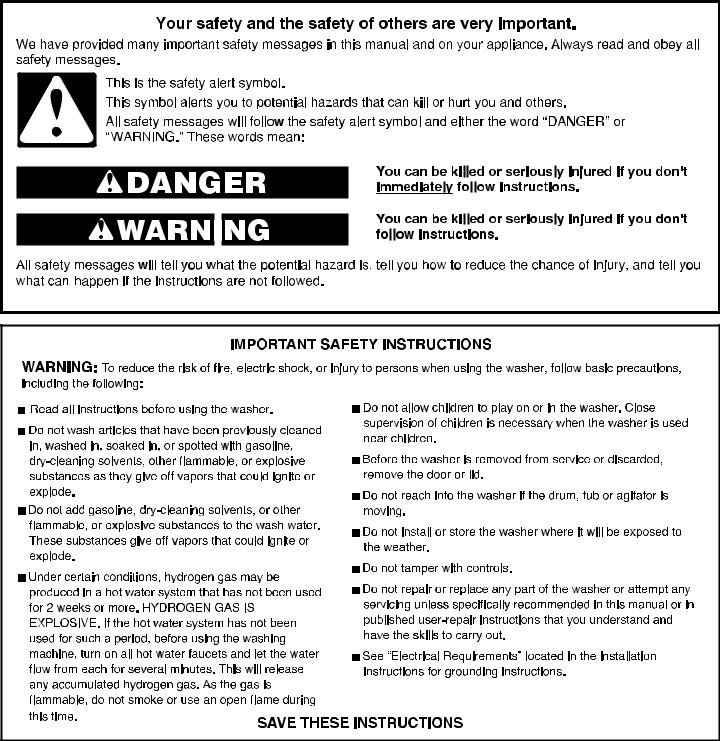
WASHER SAFETY
SPECIFICATIONS
The units described in this Use and Care Guide are sold in multiple regions with different requirements for measuring capacity.
Capacity Measure |
Models |
|
|
1CWTW4800,1CWTW4740 |
|
1CWTW4840 |
|
|
|
||
Dry Linen Capacity: A weight measure that reflects a |
15 kg (33 lb) |
|
|
maximum load size that can be loaded into the washer. |
|
||
|
|
|
|
NOM Capacity: A weight measure based on the Mexican |
15 kg (33 lb) |
|
17 kg (37 lb) |
norm (NMX-J-521/1). This standard also applies in Colombia. |
|
||
|
|
|
|
2

CONTROL PANEL AND FEATURES
Not all features and options are available on all models.
3
1 |
2 |
Model 1CWTW4840
1 |
2 |
Model 1CWTW4740 |
|
1 LOAD SIZE |
3 |
Select the setting most suitable for your load. Small will add a low amount of water for smaller loads and Super will add the most amount of water for large or bulky loads. Items need to move freely. Tightly packing can lead to poor cleaning performance, and may increase wrinkling and tangling.
2TEMPERATURE
Temperature control senses and maintains uniform water temperatures by regulating incoming hot and cold water.
Select a wash temperature based on the type of fabric and soils being washed. For best results and following the garment label instructions, use the warmest wash water safe for your fabric.
• Warm and hot water will be cooler than what your |
4 |
previous washer provided. |
|
•Even in a cold and cool water wash, some warm water may be added to the washer to maintain a minimum temperature.
4
7 6 5
4
7 |
6 |
5 |
OPTIONS (on some models)
The following options may be added to most cycles.
EXTRA RINSE
This option can be used to automatically add a second rinse to most cycles.
FABRIC SOFTENER ADDED-YES
This option must be selected if using fabric softener during a cycle. It ensures that fabric softener is added at the correct time in the rinse for even distribution.
FABRIC SOFTENER ADDED with EXTRA RINSE
This option turns on both the Fabric Softener and the Extra Rinse options.
WASH CYCLE KNOB
Use the Wash Cycle knob to select available cycles on your washer. Turn the knob to select a cycle for your laundry load. See “Cycle Guide” for detailed descriptions of cycles.
3
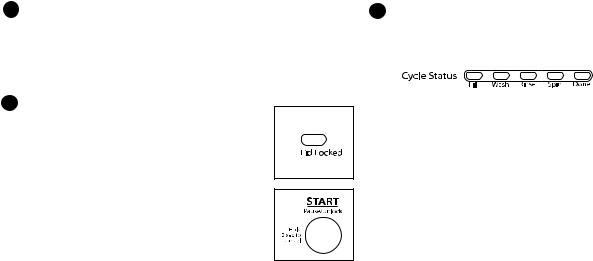
5START/PAUSE/UNLOCK BUTTON
Press to start the selected cycle; press again to pause the cycle and unlock the lid.
NOTE: If the washer is spinning, it may take several minutes to unlock the lid. Press and hold for 3 seconds to cancel a cycle.
6 LID LOCKED
To allow for proper spin operation, the lid will lock and the Lid Lock light will turn on. This light indicates that
the lid is locked and cannot be opened.
If you need to open the lid, press START/Pause/Unlock. The lid will unlock once the washer movement has stopped. This may take several minutes if the load was spinning at high speed. Press START/Pause/ Unlock again to resume the cycle.
7CYCLE STATUS INDICATORS
The Cycle Status Lights show the progress of a cycle. At each stage of the process, you may notice sounds or pauses that are different from traditional washers.
FILL/SENSING
When the START/PAUSE button is pressed, the washer will fill to the selected water level. If the lid is closed when the machine is done filling the lid will lock and the machine will begin operation.
If the lid is open when the water stops entering the machine, the cycle will not begin until the lid has been closed and the START/PAUSE button is pressed. If the cycle has not been started within 10 minutes of the water filling the washer, the washer will pump out the water.
WASH
You will hear the agitator moving the load. The motor sounds may change at different stages in the cycle.
RINSE
You will hear sounds similar to the wash cycle as the washer rinses and moves the load. You may hear the motor turning on briefly (short hum) to move the basket while filling. Fabric softener will be added if the Fabric Softener Added-Yes option was selected.
Some cycles use spray rinsing. After draining and spinning out wash water, the washer will continue to spin and spray in rinse water for the entire rinse time.
SPIN
The washer spins the load at increasing speeds for proper water removal, based on the selected cycle and spin speed.
DONE
Once the cycle is complete, this light will come on. Remove the load promptly for best results.
4

CYCLE GUIDE
For best fabric care, choose the cycle that best fits the load being washed.
Not all cycles and options are available on all models.
|
|
|
|
|
Sturdy fabrics, |
Super |
Hot |
High |
Provides maximum wash time and action for tough stains |
colorfast items, |
Wash |
Warm |
|
and soils. Use this cycle for heavily soiled or sturdy items. |
towels, jeans |
|
Cool |
|
Water-level sensing process may take longer for some |
|
|
Cold |
|
items than for others because they will absorb more water |
|
|
|
|
than other fabric types. |
|
|
|
|
|
Sturdy fabrics, |
Normal |
Hot |
High |
Use this cycle for heavily soiled or sturdy items. This cycle |
colorfast items, |
Heavy |
Warm |
|
uses spray rinses only. Use this cycle for cleaning the |
towels, jeans |
|
Cool |
|
interior of the washer. See “Washer Care.” |
|
|
Cold |
|
|
|
|
|
|
|
Cottons, linens, |
Normal |
Hot |
High |
Use this cycle for normally soiled cottons and mixed fabric |
sheets, and mixed |
Regular |
Warm |
|
loads. This cycle uses spray rinses only. |
garment loads |
|
Cool |
|
|
|
|
Cold |
|
|
|
|
|
|
|
Lightweight |
Normal |
Hot |
High |
Use this cycle for lightly soiled mixed loads. This cycle |
cotton fabrics |
Light |
Warm |
|
uses spray rinses only. |
|
|
Cool |
|
|
|
|
Cold |
|
|
|
|
|
|
|
No-iron fabrics, |
Casual or |
Hot |
Low |
Use this cycle to wash loads of no-iron fabrics such as |
cottons, perm |
Casual |
Warm |
|
sport shirts, blouses, casual business clothes, permanent |
press, linens, |
Regular |
Cool |
|
press, and blends. |
synthetics |
|
Cold |
|
|
|
|
|
|
|
Lightly-soiled |
Casual |
Hot |
Low |
Use this cycle to wash lightly-soiled loads of no-iron fabrics |
no-iron fabrics |
Light |
Warm |
|
such as sport shirts, blouses, casual business clothes, |
and synthetics |
|
Cool |
|
permanent press, and blends. |
|
|
Cold |
|
|
|
|
|
|
|
Large items such |
Bulky |
Hot |
Low |
Use this cycle to wash large items such as jackets and |
as sleeping bags, |
Items |
Warm |
|
small comforters. The washer will fill with enough water |
small comforters, |
|
Cool |
|
to wet down the load before the wash portion of the cycle |
jackets |
|
Cold |
|
begins. Do not tightly pack basket. |
|
|
|
|
|
Machine-wash |
Delicate |
Hot |
Low |
Use this cycle to wash lightly soiled garments indicating |
silks, lingerie, |
|
Warm |
|
“Machine Washable Silks” or “Gentle” cycle on the care |
washable wools |
|
Cool |
|
label. Place small items in mesh garment bags before |
|
|
Cold |
|
washing. |
Heavily soiled |
Soak |
Hot |
No Spin |
Use this cycle to soak small spots of set in stains on |
fabrics |
|
Warm |
|
fabrics. The washer will use intermittent agitation and |
|
|
Cool |
|
soaking. After time has expired, water will drain, but the |
|
|
Cold |
|
washer will not spin. Cycle is complete. |
|
|
|
|
|
Swimsuits and |
Rinse & |
Cold rinse only |
High |
Combines a rinse and high speed spin for loads requiring |
items requiring |
Spin |
|
|
an additional rinse cycle or to complete a load after a power |
rinsing without |
|
|
|
failure. Also use for loads that require rinsing only. |
detergent |
|
|
|
|
|
|
|
|
|
Dripping wet or |
Drain & |
N/A |
High |
This cycle uses a spin to shorten drying times for heavy |
hand-washed |
Spin |
|
|
fabrics or special-care items washed by hand. Use this |
items |
|
|
|
cycle to drain washer after cancelling a cycle or completing |
|
|
|
|
a cycle after a power failure. |
|
|
|
|
|
NOTE: Be sure to select Fabric Softener Added-Yes, if adding fabric softener to load (depending on model). *All rinses are cold.
5
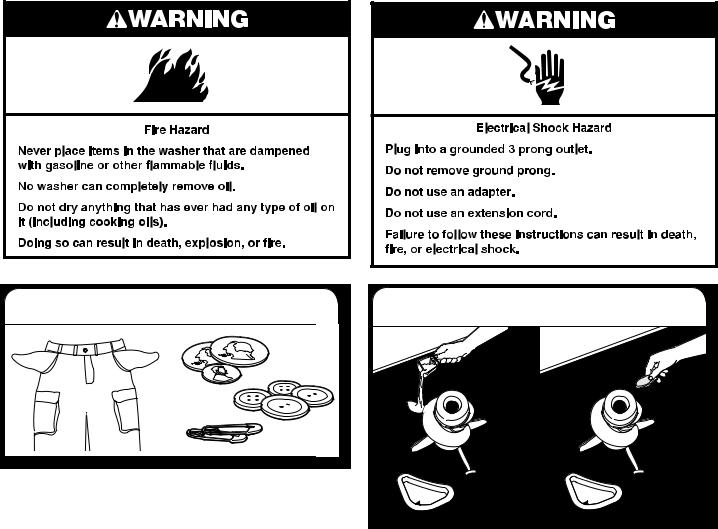
USING YOUR WASHER
1. Sort and prepare your laundry
•Empty pockets. Loose change, buttons, or any small object can pass under the agitator and become trapped, causing unexpected sounds.
•Sort items by recommended cycle, water temperature, and colorfastness.
•Separate heavily soiled items from lightly soiled.
•Separate delicate items from sturdy fabrics.
•Do not dry garments if stains remain after washing, because heat can set stains into fabric.
•Treat stains promptly.
•Close zippers, fasten hooks, tie strings and sashes, and remove non-washable trim and ornaments.
•Mend rips and tears to avoid further damage to items during washing.
Helpful Tips:
•When washing water-proof or water-resistant items, load evenly.
•Use mesh garment bags to help avoid tangling when washing delicate or small items.
•Turn knits inside out to avoid pilling. Separate lint-takers from lint-givers. Synthetics, knits, and corduroy fabrics will pick up lint from towels, rugs, and chenille fabrics.
NOTE: Always read and follow fabric care label instructions to avoid damage to your garments.
2. |
Add laundry products |
Add a measured of amount of detergent or single-dose laundry packet into the basket.
If using Oxi-type boosters, color-safe bleach, or fabric softener crystals, add to the bottom of the washer basket before adding clothes.
NOTE: Follow the manufacturer’s instructions to determine the amount of laundry products to use.
6
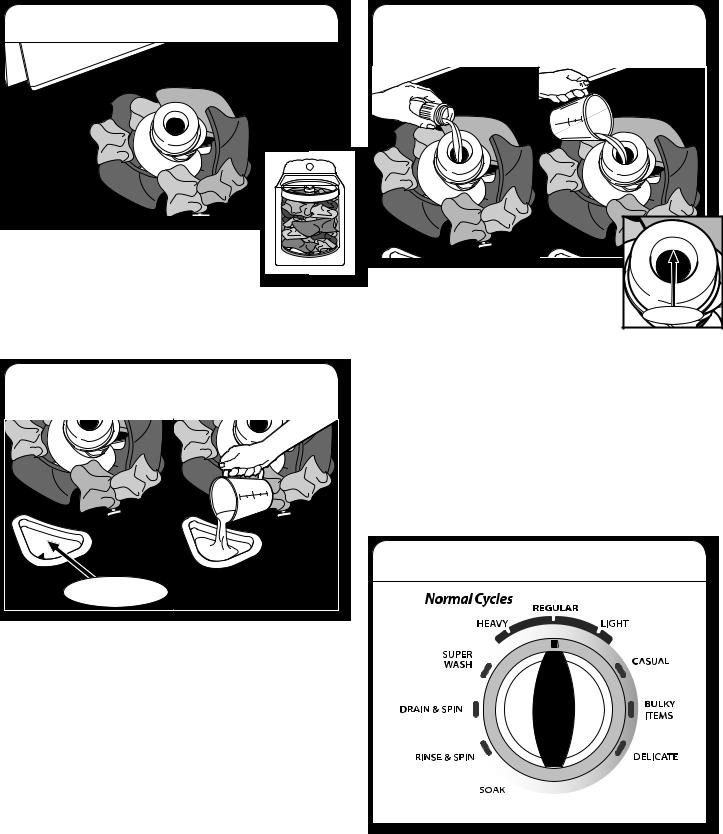
3. Load laundry into washer |
5. Add fabric softener to dispenser |
|
(on some models) |
Load garments in loose heaps evenly around basket wall. For best results, do not pack the load tightly. Do not wrap large items such as
sheets around the agitator; load them in loose piles around the sides of the basket. Try mixing different sized items to reduce tangling.
IMPORTANT: Do not tightly pack or force items into washer. Items need to move freely for best cleaning and to reduce wrinkling and tangling.
4. Add liquid chlorine bleach to dispenser
Liquid
Chlorine Bleach
Do not overfill, dilute, or use more than 1 cup (250 mL). Do not use color-safe bleach or Oxi products in the same cycle with liquid chlorine bleach.
Pour a measured amount of liquid fabric |
|
softener into dispenser; always follow |
|
manufacturer’s directions for correct amount |
|
of fabric softener based on your load size. |
MAX FILL |
IMPORTANT:
•Dilute liquid fabric softener by filling the dispenser with warm water until liquid reaches the underside of the rim. See max fill line arrows. Then select Fabric Softener Added-Yes option or Fabric Softener Added with Extra Rinse option.
•Fabric Softener Added option must be selected to “Yes” to ensure proper distribution at correct time in cycle.
Adding Liquid Fabric Softener Manually to Wash Load
During the final rinse, wait until the washer has completed filling, press the START/Pause/Unlock button to pause the washer. Lift the lid and add the measured recommended
amount of liquid fabric softener. Do not use more than the recommended amount. Close the lid and press the START/ Pause/Unlock button again to start the washer.
6. Select cycle
Model 1CWTW4840 shown
Turn cycle knob to choose your wash cycle. For more information, see “Cycle Guide”.
7
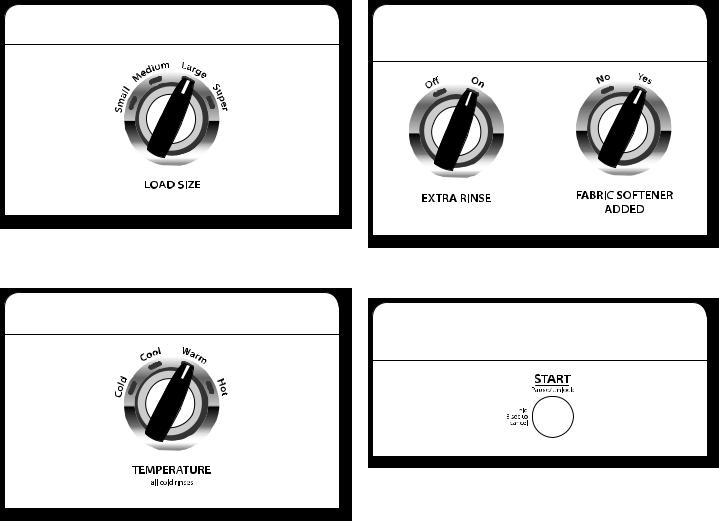
7. Select LOAD SIZE
Model 1CWTW4840 shown
Select the load size setting most suitable for your load. Small will add a low amount of water for smaller loads and Super will add the most amount of water for large or bulky loads. Items need to move freely.
8. Select TEMPERATURE
Model 1CWTW4840 shown
Once you select a cycle, select the desired wash temperature by turning the Temperature knob to the appropriate setting based on your load. All rinses are tap cold.
NOTE: Always read and follow fabric care label instructions to avoid damage to your garments.
Wash Temp |
Suggested Fabrics |
|
|
|
|
Hot |
|
|
Some cold water is added to save |
Whites and pastels |
|
energy. This will be cooler than your |
Durable garments |
|
hot water heater setting. |
||
Heavy soils |
||
|
||
|
|
|
Warm |
|
|
Some cold water will be added, so |
Bright colors |
|
this will be cooler than what your |
Moderate to light soils |
|
previous washer provided. |
||
|
||
|
|
|
Cool |
|
|
Warm water may be added to |
Colors that bleed |
|
assist in soil removal and to help |
or fade |
|
dissolve detergents. |
Light soils |
|
|
||
|
|
|
Cold |
|
|
This is the temperature from your |
Dark colors that |
|
faucet. If your tap cold water is very |
bleed or fade |
|
cold, warm water may be added |
Light soils |
|
to assist in soil removal and help |
||
|
||
dissolve detergent. |
|
|
|
|
9. Select options, if desired (on some models)
Model 1CWTW4840 shown
Select the desired cycle options. If you are using fabric softener, be sure to select one of the Fabric Softener Added-Yes options.
10. Press START/Pause/Unlock
to begin wash cycle
Press the START/Pause/Unlock button to start the wash cycle. When the cycle has finished, the DONE indicator will light. Promptly remove garments after cycle has completed to avoid odor, reduce wrinkling, and rusting of metal hooks, zippers, and snaps.
IMPORTANT: After the washer basket fills to the selected water level, the lid must be closed before the wash cycle can start. If filling stops with the lid open, close the lid and press START button.
Unlocking the lid to add garments
If you need to open the lid to add 1 or 2 missed garments:
Press START/Pause/Unlock; the lid will unlock once the washer movement has stopped. This may take several minutes if the load was spinning at high speed. Then close lid and press START/Pause/Unlock again to restart the cycle.
If lid is left open for more than 10 minutes, the water will pump out automatically.
8
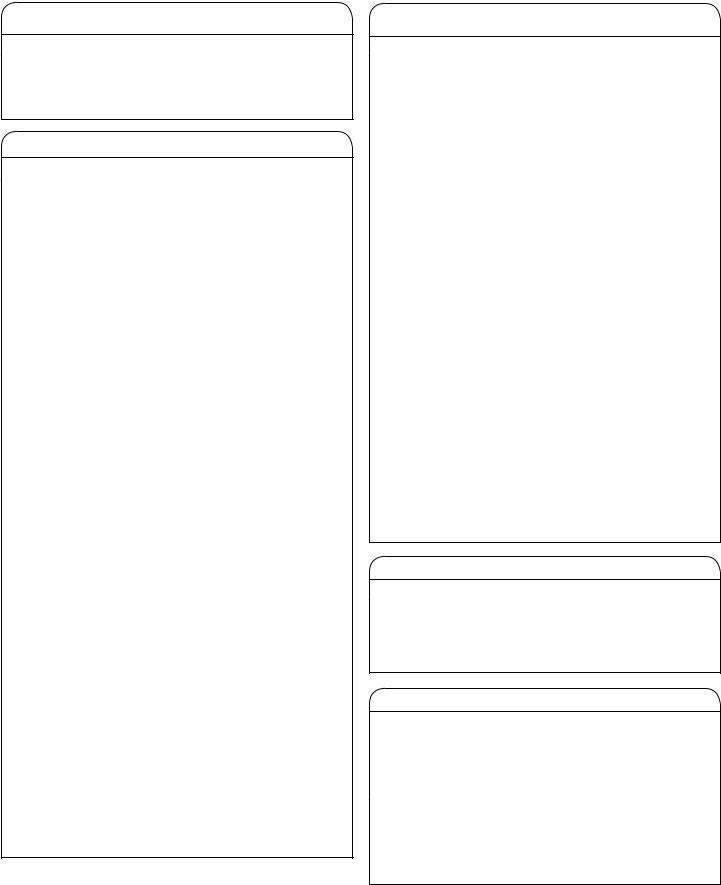
WASHER MAINTENANCE
WATER INLET HOSES
Replace inlet hoses after 5 years of use to reduce the risk of hose failure. Periodically inspect and replace inlet hoses if bulges, kinks, cuts, wear, or leaks are found.
When replacing your inlet hoses, mark the date of replacement on the label with a permanent marker.
WASHER CARE
Recommendations to Help Keep Your Washer Clean and Performing at its Best
1.Always follow the detergent manufacturer’s instructions regarding the amount of detergent to use. Never use more than the recommended amount because that may increase the rate at which detergent and soil residue accumulate inside your washer, which in turn may result
in undesirable odor.
2.Use warm and hot wash water settings sometimes (not exclusively cold water washes), because they do a better job of controlling the rate at which soils and detergent accumulate.
3.Always leave the washer lid open between uses to help dry out the washer and prevent the buildup of odor-causing residue.
Cleaning Your Top Loading Washer
Read these instructions completely before beginning the routine cleaning processes recommended below. This Washer Maintenance Procedure should be performed, at a minimum, once per month or every 30 wash cycles, whichever occurs sooner, to control the rate at which soils and detergent may otherwise accumulate in your washer.
Cleaning the Inside of the Washer
To keep your washer odor-free, follow the usage instructions provided above, and use this recommended monthly cleaning procedure:
Recommended Cycle for Cleaning the Washer
Refer to the “Cycle Guide” for the optimal cycle for cleaning the inside of the washer. Use this cycle with washer cleaner or liquid chlorine bleach as described below.
Begin procedure
1.Washer Cleaner Cycle Procedure (Recommended for Best Performance):
a.Open the washer lid and remove any clothing or items.
b.Place a washer cleaner tablet in the bottom of the washer basket.
c.Do not place a washer cleaner tablet in the detergent dispenser.
d.Do not add any detergent or other chemical to the washer when following this procedure.
e.Close the washer lid.
f.Select the cycle recommended for cleaning the inside of the washer.
g.Press the START/PAUSE button to start the cycle.
NOTE: For best results, do not interrupt cycle. If cycle must be interrupted, press START/PAUSE once or twice (depending on model). After the cycle has stopped, run a RINSE & SPIN cycle to rinse cleaner from washer.
WASHER CARE (cont.)
2.Chlorine Bleach Procedure (Alternative):
a.Open the washer lid and remove any clothing or items.
b.Add 1 cup (236 mL) of liquid chlorine bleach to the bleach compartment.
NOTE: Use of more liquid chlorine bleach than is recommended above could cause washer damage over time.
c.Close the washer lid.
d.Do not add any detergent or other chemical to the washer when following this procedure.
e.Select the cycle recommended for cleaning the inside of the washer.
f.Press the START/PAUSE button to start the cycle.
NOTE: For best results, do not interrupt cycle. If cycle must be interrupted, press START/PAUSE once or twice (depending on model). After the cycle has stopped, run a
RINSE & SPIN cycle to rinse cleaner from washer.
Cleaning the Dispensers
After a period of using your washer, you may find some residue buildup in the washer’s dispensers. To remove residue from the dispensers, wipe them with a damp cloth and towel dry. Do not attempt to remove the dispensers or trim for cleaning. The dispensers and trim are not removable. If your model has a dispenser drawer, however, remove the drawer and clean it before or after you run the Clean Washer cycle. Use an all-purpose surface cleaner, if needed.
Cleaning the Outside of the Washer
Use a soft, damp cloth or sponge to wipe away any spills. Use only mild soaps or cleaners when cleaning external washer surfaces.
IMPORTANT: To avoid damaging the washer’s finish, do not use abrasive products.
NON-USE AND VACATION CARE
Operate your washer only when you are home. If moving, or not using your washer for a period of time, follow these steps:
1.Unplug or disconnect power to washer.
2.Turn off water supply to washer, to avoid flooding due to water pressure surge.
WINTER STORAGE CARE
IMPORTANT: To avoid damage, install and store washer where it will not freeze. Because some water may stay in hoses, freezing can damage washer. If storing or moving during freezing weather, winterize your washer.
To winterize washer:
1.Shut off both water faucets; disconnect and drain water inlet hoses.
2.Put 1 qt. (1 L) of R.V.-type antifreeze in basket and run washer on RINSE & SPIN cycle for about 30 seconds
to mix antifreeze and remaining water.
3.Unplug washer or disconnect power.
9
